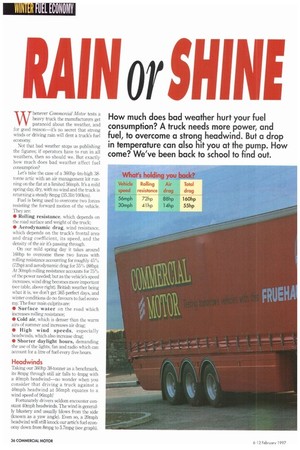RAINorSlitttlf
Page 38

Page 39

If you've noticed an error in this article please click here to report it so we can fix it.
How much does bad weather hurt your fuel consumption? A truck needs more power, and fuel, to overcome a strong headwind. But a drop in temperature can also hit you at the pump. How come? We've been back to school to find out.
Whenever Commercial Motor tests a heavy truck the manufacturers get paranoid about the weather, and for good reason—it's no secret that strong winds or driving rain will dent a truck's fuel economy.
Not that bad weather stops us publishing the figures; if operators have to run in all weathers, then so should we. But exactly how much does bad weather affect fuel consumption?
Let's take the case of a 360hp 4m-high 38tonne artic with an air management kit running on the flat at a limited 56mph. It's a mild spring day, dry, with no wind and the truck is returning a steady 8mpg (35.31k/100km).
Fuel is being used to overcome two forces resisting the forward motion of the vehicle. They are:
• Rolling resistance, which depends on the road surface and weight of the truck; • Aerodynamic drag, wind resistance, which depends on the truck's frontal area and drag coefficient, its speed, and the density of the air it's passing through.
On our mild spring day it takes around 160hp to overcome these two forces with rolling resistance accounting for roughly 45% (72hp) and aerodynamic drag for 55% (88hp), At 30mph rolling resistance accounts for 75% of the power needed; but as the vehicle's speed increases, wind drag becomes more important (see table, above right). British weather being what it is, we don't get 365 perfect days, and winter conditions do no favours to fuel economy. The four main culprits are:
• Surface water on the road which increases rolling resistance; • Cold air, which is denser than the warm airs of summer and increases air drag; • High wind speeds, especially headwinds, which also increase drag; • Shorter daylight hours, demanding the use of the lights, fan and radio which can account for a litre of fuel every five hours,
Headwinds
Taking our 360hp 38-boner as a benchmark, its 8mpg through still air falls to 4mpg with a 40mph headwind—no wonder when you consider that driving a truck against a 40mph headwind at 56mph equates to a wind speed of 96mph!
Fortunately drivers seldom encounter constant 40mph headwinds. The wind is generally blustery and usually blows from the side (known as a yaw angle). Even so, a 20mph headwind will still knock our artic's fuel economy down from 8mpg to 5.7mpg (see graph).
Temperature
Colder air creates greater air drag. The second line on our graph (representing a temperature of -5°C) shows fuel consumption with different headwinds when the temperature drops from +15°C to -5°C. Compare this with the base line and fuel consumption is down by some 5%.
Wet roads
The lowest line on the graph shows the impact of headwinds at -5°C on wet roads. A 0.5mm layer of water on the mad increases rolling resistance by nearly 25%. Compare this -5°C and water line with the optimum base line and fuel consumption under typical winter conditions goes from 8mpg to impg.
So how much does the weather affect fuel economy? When you compare the fuel return of our 38-tonner on an ideal spring day to that on a freezing, blustery wet winter's night the difference could be a much as 3mpg.
The bottom line is, if you're pitching for a long-term contract where margins are tight then you'd be wise to try and account for seasonal variations in fuel economy in your annual cost calculations.
Remember too the impact of the man behind the wheel. Training drivers to think in terms of fuel economy could help offset the impact of had weather.
No one doubts that bad weather affects your truck's fuel consumption. But at least when your next fuel bill burns a hole in the doormat you'll know why.
by Brian Weatherley
CM would like to thank Dave Skinner and Richard Kingston at Leyland Dal for their technical input and number crunching










































































































